|

May I suggest that you navigate the
site via the
index on page 01.  PRIOR PAGE / NEXT PAGE PRIOR PAGE / NEXT PAGE
The first page devoted to La Touraine is
numbered
80. And the
other pages are numbered
81,
83
&
84.
To search for specific text on this page, just press 'CTRL +
F' & then enter your search term. Test.
On this page ...
L'Illustration
1913 coverage,
an 1891 voyage,
Arthur Rubinstein,
images of Le Havre,
a La Touraine deck plan
THE 1913 COVERAGE OF THE VESSEL IN L'ILLUSTRATION.
I next feature on this page two images that appeared in the Oct. 18, 1913 edition (# 3686) of
'L'Illustration'. Such weekly magazine was published in Paris, France, and was
then in its 71st year of publication. La Touraine was of course a French vessel,
so the issue contained two most interesting images that relate directly to La Touraine.
I place them on this page, accordingly. The article itself is, of course in the
French language - a difficulty for the Webmaster with his lack of ability in that language.
The French text is now on page
15 of this site,
& having now transcribed it, it is clear that a good part of it refers
specifically to La Touraine. Hopefully we will one day have an English
translation on site.
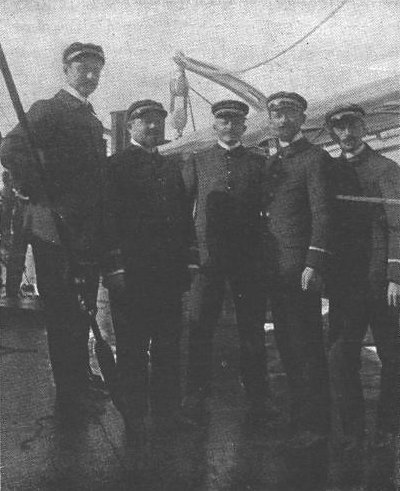 |
 |
The images? I will show you here, the two image scans. The image quality is not the greatest. But I am so happy to even have them
both.
The first
image - at left - only 2 5/8" by 3 1/4" approximately in the original, has this caption. Which means,
in English, I do believe, 'The senior staff of la Touraine. In the centre is Captain Caussin; to the left is Lieutenant Izenic, who brought on board the first
load of shipwrecked survivors of Volturno'. It is shown here somewhat
enlarged.
And the second
image - below - 5 5/8" by 4 1/4" approximately in the original, but I have cut an area
of sky in what I show. Its caption reads as recorded here.
Which means, I think 'A group of shipwrecked survivors of Volturno on board
the steamship la Touraine'. Corrections in my translations are invited. Stay tuned! |

AN ACCOUNT OF AN 1891 VOYAGE OF LA TOURAINE FROM NEW YORK TO
LE HAVRE
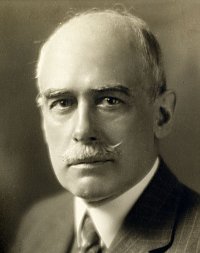 |
On Sep. 12, 1891, Theodore W. (Wells) Pietsch (1868/1930),
left New York for
Le Havre - en route to Paris, France, to enroll in the 'École des Beaux Arts'
there to
study architecture. He wrote an account of his voyage, which was aboard La Touraine
of course, & his
grandson, also Theodore W. Pietsch,
known as 'Ted', a Professor at the 'Burke Museum of Natural History and Culture' in Seattle, Washington, has kindly provided it to the webmaster.
Ted has
also kindly provided
an image (thumbnail, later in life, at left) & some extensive biographical material
about Theodore. A condensed summary of that bio material can be read below. |
.... And what a good
ship she is! The first day out, I
studied her from stem to stern, and in the days following I never tired of
visiting her gigantic engine, machinery and steerage rooms, and marvelling at
the wonderful mechanical skill required to invent and execute those mammoth
works. (Webmaster's comment: images of the engine room are on this page). It was in that vague and listless humor which you experience while watching the surf on the ocean beach that I
stood musing before those great engines, the very expression of unearthly
force, whose constant plunging motion seemed destined to go on forever. And then what a contrast to return on deck,
from the fierce and angry noise of the vibrating machinery, to the grand calm
of the sleeping Ocean, boundless and infinite, cold and treacherous, awakening
a sense of dread and horror at the thought of the power now hushed and silent!
... a feeling of
confidence and safety returns when pacing the long, broad decks of the great
ship, speeding ahead like a locomotive and steady as a river barge. What a beautiful steamer she is! How wonderfully neat and shipshape everything
about her! How well she is scrubbed and
rubbed and polished by the dozens of sailors who nurse and care for her as a
mother her child! Like a real gem of
sparkling brilliancy you hesitate to touch her, and expect to see at each turn
a notice, “Hands off!” What magnificent,
extravagant decoration meets your eye the very moment you enter the grand
staircase hall, finished in the richest mahogany, carved and polished. The great mirror directly in front as you
descend the main stair echoes the full warm tones of color, light and shade, of
the exquisite statues, vases and wall paintings, and repeats the picturesque
perspective of the stairs and balconies in front, often crowded with a gay
company of idle passengers.
Let us turn to the right and pass
through the entrance into the “Salon de Conversation.” Is not this a beautiful expression of the
style of Louis XVI? What a soft and
delicate treatment! What a sense of
color required by the artist who composed those intricate and dainty inlaid
panels that adorn the walls! What rich
and costly woods, from India, Persia, and Japan; and above all, what a
delightful arrangement for the convenience, comfort and pleasure of those fond
of company, books and music!
I know another room, which, as much
on account for the general interest it awakes among us at stated intervals
during the day as for its own intrinsic merit, cannot pass unnoticed. This is
the dining room, the rendez-vous of the whole ship’s company, the delight of
all blessed with health and appetite, the envy and regret of the seasick
voyager. What a large and spacious room
it is, so amply lighted on either side and from the great skylight above, and
arranged for the accommodation of so many without sacrificing the comfort of
one! The room is decorated in reds,
browns, greens, and golds. Elegant
tapering Corinthian columns support the balconies above. At one end is the great fireplace and mantel,
and opposite the elaborate sideboard. Smaller buffets adorn the angles and recesses.
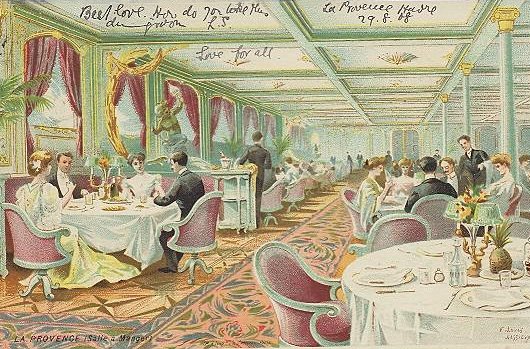
The dining room of 'La Provence',
in Aug. 1908. Likely it was as elegant as was that of 'La Touraine'. |
On either side
are grouped the small tables for the accommodation of families and parties, and
lengthwise down the centre extends the Captain’s table. Ah! what a good company
gathers here to lunch and dine and enjoy the gay society at the table! For
laughter is the very complement of a hearty meal; and the Captain himself, ever
jolly and talkative, contributed largely to the fund of enjoyment, and
entertained those immediately about him with the most humorous stories and
jokes. |
In fact, the whole room presented a cheerful
glow of animation, quite in keeping with the sumptuous and many-coursed dinner.
Oh! what dinners those were! The very recollection a dream of
Epicurus! What oysters, soups, fish,
entrees, roasts, game, salads, wires, sherbets, and desserts! What fruits of all kinds, preserves, dainty
vegetables, relishes and bonbons! For my
part, I insist, without the least hesitation, that the table d’hôte or à la
carte cuisine of the best New York hotels seldom equals and never surpasses
that of the French line steamers ....
After dinner, of course, there was
always the smoking room to repair to. This was charmingly fitted up. Dainty panels of porcelain and mosaics adorned the walls, and little
marble-topped tables served the convenience of the guests. Here the gentlemen of the poker clique played
incessantly; others read, drank and smoked and lounged on the comfortable
armchairs and cushions. A staircase
communicated direct with the cabins above, which was often very convenient.

|
And as for the
cabins and berths, I found nothing wanting, nothing to be desired, either in the
way of comfort or luxury ....
I
cannot close this account of my pleasant trip without mentioning the kindness
and attention shown me by the Captain and his officers, and the favors I
received at their hands. ....
We waved her a last farewell and then boarded the train for Paris. |  |

A deluxe cabin aboard 'La Provence',
in Aug. 1908. Likely most similar to one aboard 'La Touraine'. |
|
ARTHUR RUBINSTEIN's VOYAGE ABOARD LA TOURAINE
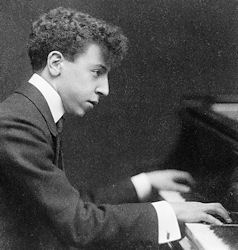 |
|
I was
delighted to learn, via the site guestbook, that famed pianist Arthur Rubinstein
(1887/1982) first travelled to the United States aboard La Touraine. André-Pierre Benguerel advises
(thanks!) that Rubinstein, in vivid colours, describes his trip aboard the vessel in his autobiography 'My young years',
Chapter 32, pp. 170-177.
The pianist was born at Lodz,
Poland, the youngest of 8 children. A fascination with the piano developed very
early & by age 4 he was described as being a child prodigy. He studied the piano
at Warsaw & at Berlin. In 1900, at age 13, he appeared with the Berlin
Philharmonic Orchestra, & in 1904 he went to Paris to further his training &
career. |
In late 1905 it would seem,
at age 18, he first travelled to the United States, aboard La Touraine, en route to his
debut performance at
Carnegie Hall in New York. The voyage was clearly a memorable one for him, both for the storm that the
vessel encountered en route & for his experience of learning poker during the journey. A
costly experience it would seem! He lost $400 - then, I would imagine, a most
considerable sum of money. A Jan. 3, 1906 New York Times article about the
poker game is here.
The pianist became a naturalised citizen of the United States in 1946. An
amazing man indeed - amongst his abilities he was fluent in eight languages.
This
page & site is not the place to detail his musical history - a good start to his background
& career can be found at this Wikipedia page.
LE HAVRE IMAGES In the next image, all of parts of postcard images, I present an interesting Le Havre street scene dating from 1915
along with an image of
the Seaman's Home, (exact date unknown), at which sailors in the 1910s would presumably have stayed while in port. At bottom right is
the Rochambeau leaving the Basin de L'Eure du Transatlantique within which the Atlantic liners docked. I presume this
is of the narrow entrance to
that Basin, that shows on the contemporary maps - and for all I know it may still be so today.
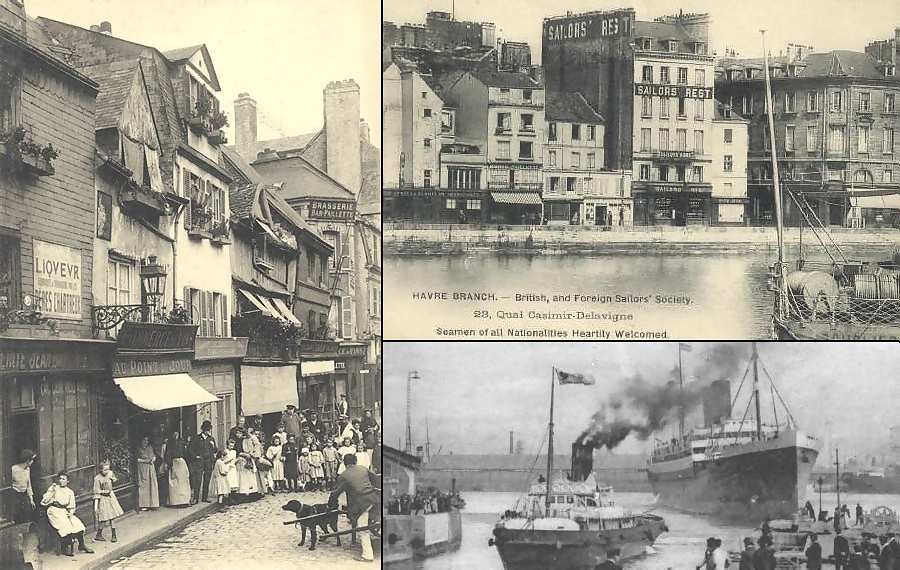
And next a most interesting print of Le Havre, dating from
the late 19th century. I hesitate to say exactly when & where this print was
first published, because I just do not know enough to be that precise. It would
seem, however, that Élisée
Reclus (1830-1905), born in France & died in Belgium, created & had
published, a massive number of volumes of geographical material, including a
series entitled 'The Earth and Its Inhabitants'. The webmaster's confusion comes
from the fact that there would seem to be a number of series of such volumes,
including one said to be of 19 volumes & published in the period of 1876
through 1894. There would seem to have perhaps been 5 volumes re Europe, 4
volumes re Africa, & other volumes re other areas of the world. I think that
this print appeared in Volume II of Europe, which volume covered France. What I
think is a copy of that particular volume, with French text, was
sold on e-Bay
on Jul. 15, 2005 for EUR 56 or approximately U.S. $67.50. The
English language publisher in the 1880s would seem to have been D. Appleton and
Company of New York, but I am sure that the volumes were published in many other
languages & probably in many different countries also. J. S. Virtue & Co. may
have also published the volumes in London, England. Certainly Librairie Hachette et Cie
published them in Paris, France.
I refer you to other sources for more information about Élisée
Reclus. Most of the info that I saw was, however, in the French language.
Anyway the most attractive print of Le Havre, which I hope you will enjoy, is of about 7 1/2
inches x 5 1/4 inches in size in the original. I cannot read the name of the artist at bottom right.
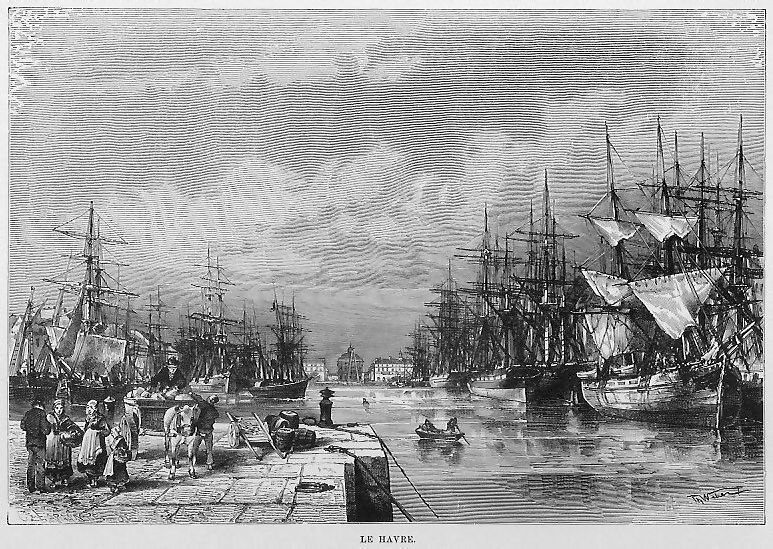
A 'LA TOURAINE' DECK PLAN
Presenting deck plans is a most difficult matter generally due to their large size
& shape. I
am glad however to present the following images, the first being the plan title
& the second an assembly of three plan
sections, both re a now long since expired e-Bay item - a deck plan of La Touraine
published by J. Ottman of New York at or about year 1900. The plan was a four fold
sheet of 19 x 12 inches in size.
I have not sought the approval of the vendor for the use of this
material here, indeed,
I do not even know
which vendor it was or if the plan was, in fact, sold at the time. Hopefully its inclusion in these non-profit & informational pages will not
be of concern.

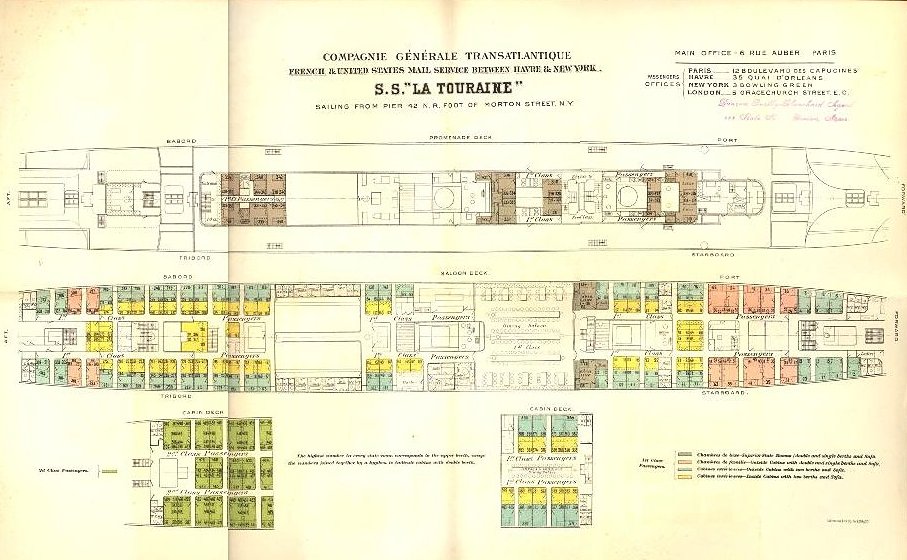
Maybe you can provide
additional data. Or images?
This page will, hopefully, track data about the
La Touraine as it comes to hand. And hopefully data as it specifically relates to the
Volturno tragedy.
Other La Touraine pages are numbered 80,
81,
83
&
84.
If any visitor can clarify
(or correct) or provide more information about any of these
matters, I would truly welcome
their help.
May I suggest that you navigate the
site via the
index on page 01.  PRIOR PAGE / NEXT PAGE PRIOR PAGE / NEXT PAGE
To the Special Pages Index.
| A SITE SEARCH FACILITY
THE GUEST BOOK - GO
HERE
|
|
THEODORE W. (WELLS) PIETSCH (1868/1930)
A few words about Theodore W. Pietsch,
the author of the 'La Touraine' text above. He was born in
Chicago in 1868, graduated from the Massachusetts Institute of Technology (MIT)
in 1889, & worked at architectural firms in Chicago until 1891 when he travelled
to the 'École des Beaux Arts' in Paris, France, to study architecture. He
studied there for 6 years & returned to the U.S. in 1898. He was a noted
architect in the U.S. during his lifetime, initially in New York & then in
Washington & in Baltimore. At Baltimore, he designed buildings as a result of the
Great Baltimore Fire of 1904 - a most varied group of structures including the
Public Market, Broadway Pier, Fallsway Viaduct, commercial buildings & perhaps
his most famous building of all, the St. Philip & St. James Catholic Church on
North Charles Street. His lifetime achievements & awards are many, indeed, far more than
these Volturno pages can recognise. Alas, in 1930, he died at his own hand, leaving his
wife Gertrude, née Zell, (1888/1968) & 3 children, all boys. He was suffering from ill
health & had lost a large sum of money during the 1929 stock market crash. Those
concerns may well have driven him to commit suicide. Others believe however, (not
my words - I quote),
'that constant nagging from his wife to convert to Catholicism drove him to it'.
He was, I learn, a Protestant & Gertrude was Catholic & over a great many years Gertrude
had wished
him to convert to the Catholic faith. He is buried in New Cathedral Cemetery
in Baltimore, as also is Gertrude, though they are not, apparently, side by side.
Ted,
Theodore's grandson, is the third to bear the name of Theodore W. Pietsch. His
father, the oldest of the 3 sons referred to above, was born in 1912, & was
Theodore W. Pietsch #2.
|










